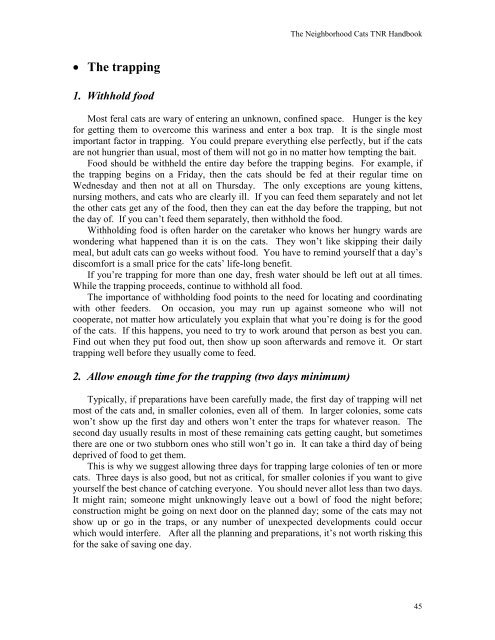Create successful ePaper yourself
Turn your PDF publications into a flip-book with our unique Google optimized e-Paper software.
• The trapping<br />
1. Withhold food<br />
The <strong>Neighborhood</strong> <strong>Cats</strong> <strong>TNR</strong> <strong>Handbook</strong><br />
Most feral cats are wary of entering an unknown, confined space. Hunger is the key<br />
for getting them to overcome this wariness and enter a box trap. It is the single most<br />
important factor in trapping. You could prepare everything else perfectly, but if the cats<br />
are not hungrier than usual, most of them will not go in no matter how tempting the bait.<br />
Food should be withheld the entire day before the trapping begins. For example, if<br />
the trapping begins on a Friday, then the cats should be fed at their regular time on<br />
Wednesday and then not at all on Thursday. The only exceptions are young kittens,<br />
nursing mothers, and cats who are clearly ill. If you can feed them separately and not let<br />
the other cats get any of the food, then they can eat the day before the trapping, but not<br />
the day of. If you can’t feed them separately, then withhold the food.<br />
Withholding food is often harder on the caretaker who knows her hungry wards are<br />
wondering what happened than it is on the cats. They won’t like skipping their daily<br />
meal, but adult cats can go weeks without food. You have to remind yourself that a day’s<br />
discomfort is a small price for the cats’ life-long benefit.<br />
If you’re trapping for more than one day, fresh water should be left out at all times.<br />
While the trapping proceeds, continue to withhold all food.<br />
The importance of withholding food points to the need for locating and coordinating<br />
with other feeders. On occasion, you may run up against someone who will not<br />
cooperate, not matter how articulately you explain that what you’re doing is for the good<br />
of the cats. If this happens, you need to try to work around that person as best you can.<br />
Find out when they put food out, then show up soon afterwards and remove it. Or start<br />
trapping well before they usually come to feed.<br />
2. Allow enough time for the trapping (two days minimum)<br />
Typically, if preparations have been carefully made, the first day of trapping will net<br />
most of the cats and, in smaller colonies, even all of them. In larger colonies, some cats<br />
won’t show up the first day and others won’t enter the traps for whatever reason. The<br />
second day usually results in most of these remaining cats getting caught, but sometimes<br />
there are one or two stubborn ones who still won’t go in. It can take a third day of being<br />
deprived of food to get them.<br />
This is why we suggest allowing three days for trapping large colonies of ten or more<br />
cats. Three days is also good, but not as critical, for smaller colonies if you want to give<br />
yourself the best chance of catching everyone. You should never allot less than two days.<br />
It might rain; someone might unknowingly leave out a bowl of food the night before;<br />
construction might be going on next door on the planned day; some of the cats may not<br />
show up or go in the traps, or any number of unexpected developments could occur<br />
which would interfere. After all the planning and preparations, it’s not worth risking this<br />
for the sake of saving one day.<br />
45


